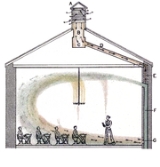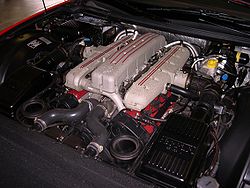
Plenum chamber
Encyclopedia
A plenum chamber is a pressurised housing containing a gas or fluid (typically air) at positive pressure
(pressure higher than surroundings). One function of the plenum can be to equalise pressure for more even distribution, because of irregular supply or demand. A plenum chamber can also work as an acoustic silencer device.
Examples of plenum chambers include those used with:
 The. term "plenum" derives originally from classical theories and the notion that "Nature abhors a vacuum
The. term "plenum" derives originally from classical theories and the notion that "Nature abhors a vacuum
". These gave rise to the notion of 17th century 'plenum' as the opposite of vacuum
, and all things "being either Plenum or Vacuum".
By the 19th century, the development of mechanical fans and industrial machinery had provided another, more technical use. This referred to "a system of artificial ventilation", which used a pressure raised slightly above atmospheric pressure, in contrast to the "vacuum system" which used a pressure below from atmospheric. At a time when high pressure steam or hydraulic
systems were well established, these were a distinct set of systems based on low pressure and high volume flows.
 Supercharged
Supercharged
piston engines
typically use many cylinders arranged in-line and one or two superchargers. Superchargers deliver air at a relatively constant rate, while cylinders demand it in a varying manner, as the valves open and as piston speed varies through the stroke. Simple direct ducting would give problems where the nearest cylinders received more airflow. The pulsating demand from the cylinders would also show problems of either pressure waves in the duct, or a shortage of inlet air towards the end of the inlet phase.
The solution is to provide a large-volume plenum chamber between the inlet and the cylinders. This has two benefits: it evens out the difference in path restriction between cylinders (distribution across space), secondly it provides a large-volume buffer against pressure changes (distribution over time).
was a motorcycle
whose air-cooled twin-rotor Wankel engine
was developed by David Garside at BSA. Wankel engines run very hot, so Garside gave this air-cooled motor additional cooling air that was filtered and drawn first through the rotors and then through a large plenum chamber into the combustion chambers via carburetors. The plenum (a sheet-alloy item which doubled as a semi-monocoque
spine frame) partly cooled the air, and the transfer of latent heat
during the carburation process further reduced the temperature of this fuel-air mixture, but its volumetric efficiency
was still somewhat impaired. The cooling air filter was mounted below the steering head (between the forks) to provide a partial ram air
effect. (The engine was lubricated by oil-injection, but the fuel-air mix also carried a mist of oil from the interior of the rotors, which helped to lubricate the rotor tips).
 Practical hovercraft
Practical hovercraft
use a peripheral skirt system, where the air from the lift fans is routed to a narrow slot around the edge of the hull, and bounded by a flexible skirt. Distribution of this air from the fans to the periphery is through a large-volume plenum chamber, so as to provide even distribution of airflow without sensitivity to the length of the direct path.
Positive pressure
Positive pressure is a pressure within a system that is greater than the environment that surrounds that system. Consequently if there is any leak from the positively pressured system it will egress into the surrounding environment....
(pressure higher than surroundings). One function of the plenum can be to equalise pressure for more even distribution, because of irregular supply or demand. A plenum chamber can also work as an acoustic silencer device.
Examples of plenum chambers include those used with:
- Superchargers
- HovercraftHovercraftA hovercraft is a craft capable of traveling over surfaces while supported by a cushion of slow moving, high-pressure air which is ejected against the surface below and contained within a "skirt." Although supported by air, a hovercraft is not considered an aircraft.Hovercraft are used throughout...
- Corliss steam engineCorliss Steam EngineA Corliss steam engine is a steam engine, fitted with rotary valves and with variable valve timing patented in 1849, invented by and named after the American engineer George Henry Corliss in Providence, Rhode Island....
s - Raised floors and false ceilings in equipment rooms
- Some organOrgan (music)The organ , is a keyboard instrument of one or more divisions, each played with its own keyboard operated either with the hands or with the feet. The organ is a relatively old musical instrument in the Western musical tradition, dating from the time of Ctesibius of Alexandria who is credited with...
s (to supplement the bellowsBellowsA bellows is a device for delivering pressurized air in a controlled quantity to a controlled location.Basically, a bellows is a deformable container which has an outlet nozzle. When the volume of the bellows is decreased, the air escapes through the outlet...
)
Etymology

Horror vacui (physics)
In physics horror vacui, or plenism, is a theory first proposed by Aristotle in the Fourth book of Physics that nature abhors a vacuum, and therefore empty space would always be trying to suck in gas or liquids to avoid being empty. The theory was widely accepted for a long time and supported by...
". These gave rise to the notion of 17th century 'plenum' as the opposite of vacuum
Vacuum
In everyday usage, vacuum is a volume of space that is essentially empty of matter, such that its gaseous pressure is much less than atmospheric pressure. The word comes from the Latin term for "empty". A perfect vacuum would be one with no particles in it at all, which is impossible to achieve in...
, and all things "being either Plenum or Vacuum".
By the 19th century, the development of mechanical fans and industrial machinery had provided another, more technical use. This referred to "a system of artificial ventilation", which used a pressure raised slightly above atmospheric pressure, in contrast to the "vacuum system" which used a pressure below from atmospheric. At a time when high pressure steam or hydraulic
Hydraulic cylinder
A Hydraulic cylinder is a mechanical actuator that is used to give a unidirectional force through a unidirectional stroke. It has many applications, notably in engineering vehicles.- Operation :...
systems were well established, these were a distinct set of systems based on low pressure and high volume flows.
Supercharging

Supercharger
A supercharger is an air compressor used for forced induction of an internal combustion engine.The greater mass flow-rate provides more oxygen to support combustion than would be available in a naturally aspirated engine, which allows more fuel to be burned and more work to be done per cycle,...
piston engines
Reciprocating engine
A reciprocating engine, also often known as a piston engine, is a heat engine that uses one or more reciprocating pistons to convert pressure into a rotating motion. This article describes the common features of all types...
typically use many cylinders arranged in-line and one or two superchargers. Superchargers deliver air at a relatively constant rate, while cylinders demand it in a varying manner, as the valves open and as piston speed varies through the stroke. Simple direct ducting would give problems where the nearest cylinders received more airflow. The pulsating demand from the cylinders would also show problems of either pressure waves in the duct, or a shortage of inlet air towards the end of the inlet phase.
The solution is to provide a large-volume plenum chamber between the inlet and the cylinders. This has two benefits: it evens out the difference in path restriction between cylinders (distribution across space), secondly it provides a large-volume buffer against pressure changes (distribution over time).
Norton Classic
The Norton ClassicNorton Classic
The Classic is a motorcycle built in 1987 by Norton as a special edition of just 100 machines.The Classic used an air-cooled twin-rotor Wankel engine that had been developed by David Garside at BSA...
was a motorcycle
Motorcycle
A motorcycle is a single-track, two-wheeled motor vehicle. Motorcycles vary considerably depending on the task for which they are designed, such as long distance travel, navigating congested urban traffic, cruising, sport and racing, or off-road conditions.Motorcycles are one of the most...
whose air-cooled twin-rotor Wankel engine
Wankel engine
The Wankel engine is a type of internal combustion engine using an eccentric rotary design to convert pressure into a rotating motion instead of using reciprocating pistons. Its four-stroke cycle takes place in a space between the inside of an oval-like epitrochoid-shaped housing and a rotor that...
was developed by David Garside at BSA. Wankel engines run very hot, so Garside gave this air-cooled motor additional cooling air that was filtered and drawn first through the rotors and then through a large plenum chamber into the combustion chambers via carburetors. The plenum (a sheet-alloy item which doubled as a semi-monocoque
Monocoque
Monocoque is a construction technique that supports structural load by using an object's external skin, as opposed to using an internal frame or truss that is then covered with a non-load-bearing skin or coachwork...
spine frame) partly cooled the air, and the transfer of latent heat
Latent heat
Latent heat is the heat released or absorbed by a chemical substance or a thermodynamic system during a process that occurs without a change in temperature. A typical example is a change of state of matter, meaning a phase transition such as the melting of ice or the boiling of water. The term was...
during the carburation process further reduced the temperature of this fuel-air mixture, but its volumetric efficiency
Volumetric efficiency
Volumetric efficiency in internal combustion engine design refers to the efficiency with which the engine can move the charge into and out of the cylinders. More specifically, volumetric efficiency is a ratio of what quantity of fuel and air actually enters the cylinder during induction to the...
was still somewhat impaired. The cooling air filter was mounted below the steering head (between the forks) to provide a partial ram air
Ram-air intake
A ram-air intake is any intake design which uses the dynamic air pressure created by vehicle motion to increase the static air pressure inside of the intake manifold on an engine, thus allowing a greater massflow through the engine and hence increasing engine power.The ram air intake works by...
effect. (The engine was lubricated by oil-injection, but the fuel-air mix also carried a mist of oil from the interior of the rotors, which helped to lubricate the rotor tips).
Hovercraft

Hovercraft
A hovercraft is a craft capable of traveling over surfaces while supported by a cushion of slow moving, high-pressure air which is ejected against the surface below and contained within a "skirt." Although supported by air, a hovercraft is not considered an aircraft.Hovercraft are used throughout...
use a peripheral skirt system, where the air from the lift fans is routed to a narrow slot around the edge of the hull, and bounded by a flexible skirt. Distribution of this air from the fans to the periphery is through a large-volume plenum chamber, so as to provide even distribution of airflow without sensitivity to the length of the direct path.

